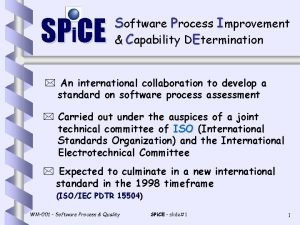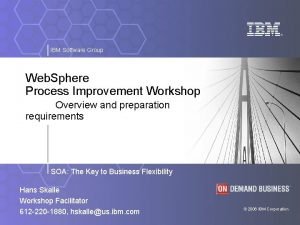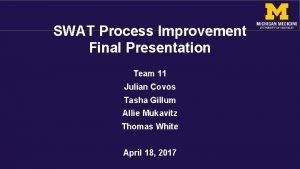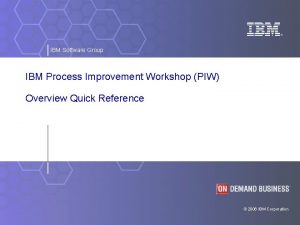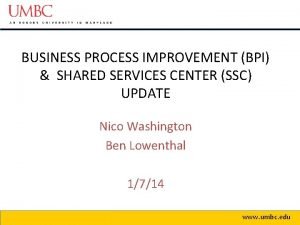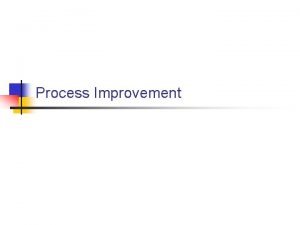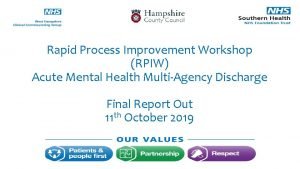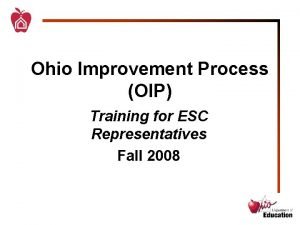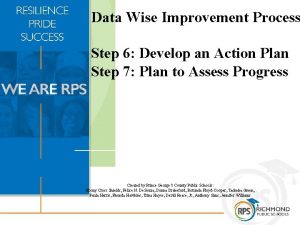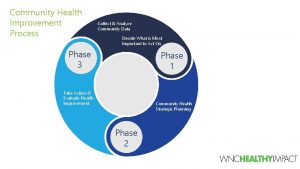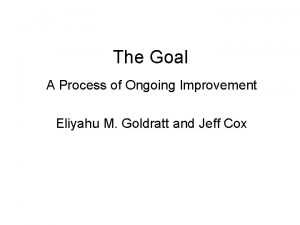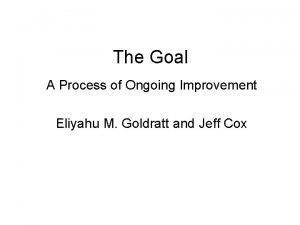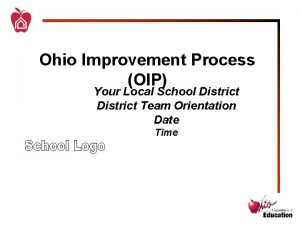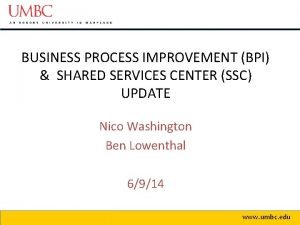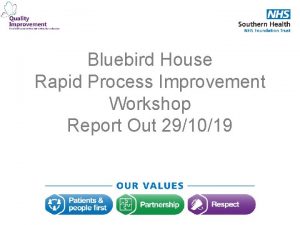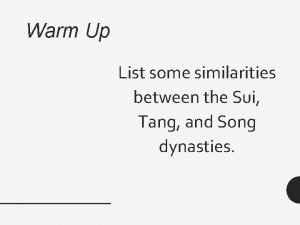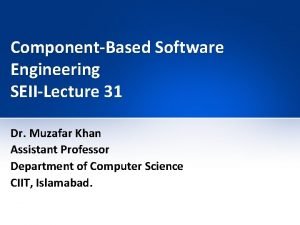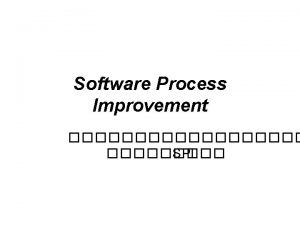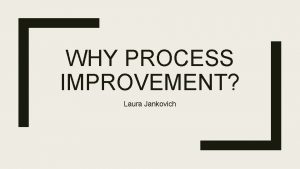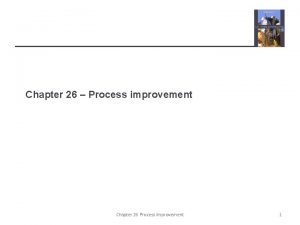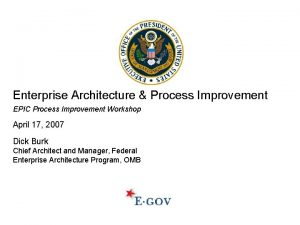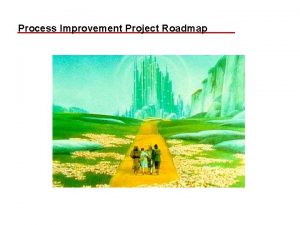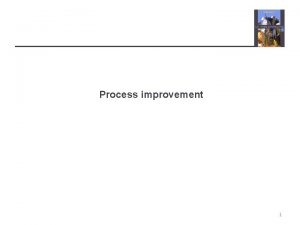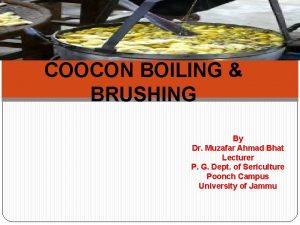Software Process Improvement SEIILecture 24 Dr Muzafar Khan





![Maturity Model [1/2] • Overall indication of process maturity • Capability maturity model • Maturity Model [1/2] • Overall indication of process maturity • Capability maturity model •](https://slidetodoc.com/presentation_image/11d0e4c7abcab3fc7bad53d9d5258bbb/image-6.jpg)
![Maturity Model [2/2] • Level-3, Defined – Processes are documented, standardized, and integrated into Maturity Model [2/2] • Level-3, Defined – Processes are documented, standardized, and integrated into](https://slidetodoc.com/presentation_image/11d0e4c7abcab3fc7bad53d9d5258bbb/image-7.jpg)
![Four Levels of Immaturity [1/2] • Level-0, Negligent – Failure to allow successful development Four Levels of Immaturity [1/2] • Level-0, Negligent – Failure to allow successful development](https://slidetodoc.com/presentation_image/11d0e4c7abcab3fc7bad53d9d5258bbb/image-8.jpg)
![Four Levels of Immaturity [2/2] • Level-2, Contemptuous – Disregard for good software engineering Four Levels of Immaturity [2/2] • Level-2, Contemptuous – Disregard for good software engineering](https://slidetodoc.com/presentation_image/11d0e4c7abcab3fc7bad53d9d5258bbb/image-9.jpg)







![Risk Management for SPI [1/2] • • SPI is a risky undertaking Lack of Risk Management for SPI [1/2] • • SPI is a risky undertaking Lack of](https://slidetodoc.com/presentation_image/11d0e4c7abcab3fc7bad53d9d5258bbb/image-17.jpg)
![Risk Management for SPI [2/2] • Risk categories – Budget and cost – Content Risk Management for SPI [2/2] • Risk categories – Budget and cost – Content](https://slidetodoc.com/presentation_image/11d0e4c7abcab3fc7bad53d9d5258bbb/image-18.jpg)
![Critical Success Factors [1/2] • Management commitment and support – Organizational and culture changes Critical Success Factors [1/2] • Management commitment and support – Organizational and culture changes](https://slidetodoc.com/presentation_image/11d0e4c7abcab3fc7bad53d9d5258bbb/image-19.jpg)
![Critical Success Factors [2/2] • A customized SPI strategy – Consider the local environment Critical Success Factors [2/2] • A customized SPI strategy – Consider the local environment](https://slidetodoc.com/presentation_image/11d0e4c7abcab3fc7bad53d9d5258bbb/image-20.jpg)

- Slides: 21

Software Process Improvement SEII-Lecture 24 Dr. Muzafar Khan Assistant Professor Department of Computer Science CIIT, Islamabad.

Recap • Class-oriented metrics – Weighted methods per class, depth of the inheritance tree, number of children, coupling, response for class, lack of cohesion • Component-level design metrics – Cohesion, coupling, and complexity • Operation-oriented metrics – Average operation size, operation complexity average number of parameters per operation • • Design metrics for Web. Apps Metrics for source code Metrics for object-oriented testing Metrics for maintenance 2

Software Process Improvement • Triple constraint • Effective software process can be defined in effective manner • Assessment of existing process based on the defined effective process • Meaningful strategy to transform the process • It is not free • Reduced costs after the process improvement 3

SPI Framework 4 Figure source: Software Engineering: A Practitioner’s Approach, R. S. Pressman, 7 th ed. , p. 788

SPI Support Groups • Quality certifiers – Process quality leads to product quality • Formalists – Process workflow, modeling languages • Tool advocates – Tool-oriented • Practitioners – Project-level planning and metrics • Reformers – Organizational change, human issues • Ideologists – Suitability for particular domain or organization structure 5
![Maturity Model 12 Overall indication of process maturity Capability maturity model Maturity Model [1/2] • Overall indication of process maturity • Capability maturity model •](https://slidetodoc.com/presentation_image/11d0e4c7abcab3fc7bad53d9d5258bbb/image-6.jpg)
Maturity Model [1/2] • Overall indication of process maturity • Capability maturity model • Level-5, Optimized – Quantitative feedback to identify process weaknesses – Pro-active approach to strengthen it – Software processes are evaluated and updated to prevent known types of defects from recurring • Level-4, Managed – Detailed process and product metrics – Meaningful variations in process performance can be distinguished from noise – Trends can be predicted in process and product quality 6
![Maturity Model 22 Level3 Defined Processes are documented standardized and integrated into Maturity Model [2/2] • Level-3, Defined – Processes are documented, standardized, and integrated into](https://slidetodoc.com/presentation_image/11d0e4c7abcab3fc7bad53d9d5258bbb/image-7.jpg)
Maturity Model [2/2] • Level-3, Defined – Processes are documented, standardized, and integrated into a standard software process – All projects follow an approved, customized version of process • Level-2, Repeatable – Basic processes are established to track cost, schedule, and functionality – Planning and managing new products is based on experience • Level-1, Initial – Few processes are defined – Success depends on individual efforts 7
![Four Levels of Immaturity 12 Level0 Negligent Failure to allow successful development Four Levels of Immaturity [1/2] • Level-0, Negligent – Failure to allow successful development](https://slidetodoc.com/presentation_image/11d0e4c7abcab3fc7bad53d9d5258bbb/image-8.jpg)
Four Levels of Immaturity [1/2] • Level-0, Negligent – Failure to allow successful development process – All problems are perceived to be technical – Managerial and quality assurance activities are considered as overhead • Level-1, Obstructive – Counterproductive processes are imposed – Processes are rigidly defined – Adherence to the form is stressed – Status quo, no power delegation 8
![Four Levels of Immaturity 22 Level2 Contemptuous Disregard for good software engineering Four Levels of Immaturity [2/2] • Level-2, Contemptuous – Disregard for good software engineering](https://slidetodoc.com/presentation_image/11d0e4c7abcab3fc7bad53d9d5258bbb/image-9.jpg)
Four Levels of Immaturity [2/2] • Level-2, Contemptuous – Disregard for good software engineering – Complete schism between software development activities and process improvement activities – No training program • Level-3, Undermining – Total neglect of own charter – Conscious discrediting of peer organization’s process improvement efforts – Rewarding failure and poor performance 9

SPI Process • Who need SPI – Large organizations? • How to initiate the process • SEI proposed IDEAL – Initiating, Diagnosing, Establishing, Acting, and Learning • Another approach – Look in the mirror, then get smarter, select the process model, instantiate the model, evaluate what has been done 10

Assessment and Gap Analysis • Before starting the journey, know precisely where you are • First road-map activity – assessment – – – – Uncover strengths and weaknesses Examine existing generic mechanisms / process activities Is the objective of the action clearly defined? Are work products required as input and produced as output identified and described? Are the work tasks to be performed clearly described? Are the people who must perform the action identified by role? Have metrics for the action been established? Are tools available to support the action? 11

Assessment and Gap Analysis • Focus on the following attributes • Consistency – Important activities, actions, and tasks applied • Sophistication – Level of sophistication for management and technical actions performed • Acceptance – Software process and SE practice acceptance by management and technical staff • Commitment – Management commitment to provide resources to achieve above attributes 12

Education and Training • Generic concepts and methods – Focus on managers and practitioners – Process and practice – Intellectual tools to apply process effectively and to make rational decisions about improvements • Specific technology and tools – Focus on practitioners – Training for tools used in process • Business communication and quality-related topics – Focus on all stakeholders – “soft” topics – Better communication and quality 13

Selection and Justification • • Suitable process model Set of framework activities to be applied Major work products to be produced Quality assurance checkpoints to assess progress Focus on weaknesses Consensus is difficult Bad choice can do more harm than good Once a choice is made, efforts should be done 14

Installation / Migration • Software process redesign • Feel of change • Sometimes entirely new process is recommended • Substantial organizational and technological transition is involved • If changes are minor, process migration • Incremental migration is more effective strategy 15

Evaluation • Evaluation occurs throughout SPI • Qualitative factors – Management and practitioners’ attitudes • Quantitative metrics – Product related metrics 16
![Risk Management for SPI 12 SPI is a risky undertaking Lack of Risk Management for SPI [1/2] • • SPI is a risky undertaking Lack of](https://slidetodoc.com/presentation_image/11d0e4c7abcab3fc7bad53d9d5258bbb/image-17.jpg)
Risk Management for SPI [1/2] • • SPI is a risky undertaking Lack of management support Cultural resistance by technical staff Poorly planned SPI strategy Overly formal approach to SPI Selection of inappropriate process Risk management at three points – Prior to the initiation of SPI road map – During the execution of SPI activities – During the evaluation activity that follows the initiation 17
![Risk Management for SPI 22 Risk categories Budget and cost Content Risk Management for SPI [2/2] • Risk categories – Budget and cost – Content](https://slidetodoc.com/presentation_image/11d0e4c7abcab3fc7bad53d9d5258bbb/image-18.jpg)
Risk Management for SPI [2/2] • Risk categories – Budget and cost – Content and deliverables – Culture – Maintenance of SPI deliverables – Mission and goals – Organizational management – Organizational stability – Process stakeholders – Schedule for SPI developments – SPI development environment and process – SPI project management and staff 18
![Critical Success Factors 12 Management commitment and support Organizational and culture changes Critical Success Factors [1/2] • Management commitment and support – Organizational and culture changes](https://slidetodoc.com/presentation_image/11d0e4c7abcab3fc7bad53d9d5258bbb/image-19.jpg)
Critical Success Factors [1/2] • Management commitment and support – Organizational and culture changes – Senior business managers should recognize the importance of software – Technical managers should be involved in the development of local SPI strategy • Staff involvement – SPI cannot imposed top down or from outside • Process integration and understanding – Process should be integrated with other business processes and requirements 19
![Critical Success Factors 22 A customized SPI strategy Consider the local environment Critical Success Factors [2/2] • A customized SPI strategy – Consider the local environment](https://slidetodoc.com/presentation_image/11d0e4c7abcab3fc7bad53d9d5258bbb/image-20.jpg)
Critical Success Factors [2/2] • A customized SPI strategy – Consider the local environment • Solid management of the SPI project – SPI is a project like any other – Project management 20

Summary • • • Software process improvement Framework for SPI support groups, maturity and immaturity models Assessment and gap analysis Education and training Selection and justification Installation / migration Evaluation Risk management Critical success factors 21
 Software process improvement and capability determination
Software process improvement and capability determination Peer inspections a pragmatic view
Peer inspections a pragmatic view Process improvement workshop examples
Process improvement workshop examples Standard cmmi appraisal method for process improvement
Standard cmmi appraisal method for process improvement Swat julian
Swat julian 7 step improvement process
7 step improvement process Ibm process improvement
Ibm process improvement Shared services process improvement
Shared services process improvement Test improvement process
Test improvement process Community health improvement process
Community health improvement process Process improvement workshop agenda
Process improvement workshop agenda Ohio improvement process
Ohio improvement process Data wise action plan template
Data wise action plan template Wnchi
Wnchi Herbie the goal
Herbie the goal The goal boy scout hike
The goal boy scout hike Rapid process improvement
Rapid process improvement Oip process
Oip process Step 1 in 7 step improvement process
Step 1 in 7 step improvement process Shared services process improvement
Shared services process improvement Rapid process improvement workshop
Rapid process improvement workshop Genghis khan dna map
Genghis khan dna map
